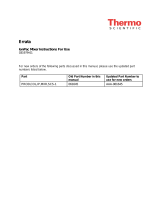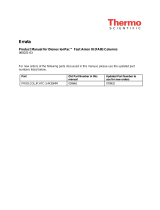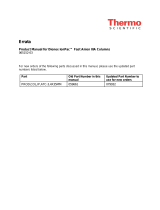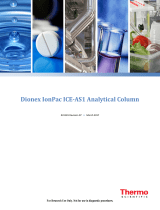Page is loading ...

Errata
Product Manual for the Dionx IonPac™ Cation Polisher
061777-01
For new orders of the following parts discussed in this manual, please use the updated part
numbers listed below.
Part Old Part Number in this
manual Updated Part Number to
use for new orders
ASSY,COIL,2ML/MIN,1000PSI,EG40 053763 AAA-053763
ASSY,ICS3/5 AS,-IV,+SP,-ST 061777 AAA-061777

IonPac Cation Polisher Manual 1
Document No: 061777-01 © 2007 Dionex January 2007
Product Manual
For
IonPac® Cation Polisher
IonPac CP1 Na+ Form Cation Polisher Column 6 x 16 mm (P/N 064930)
IonPac CP2 H+ Form Cation Polisher Column 9 x 24 mm (P/N 064931)
Dionex® Corporation, 2007
Document No : 061777
Revision 01
January 2007

IonPac Cation Polisher Manual 2
Document No: 061777-01 © 2007 Dionex January 2007
Table of Contents
1. INTRODUCTION..............................................................................................3
2. INSTALLATION AND OPERATION.............................................................5
2.1. Hardware Configuration........................................................................................................5
2.1.1. CP1 Na+ Form Cation Polisher Column Configuration....................................................5
2.1.2. CP2 H+ Form Cation Polisher Column Configuration.....................................................5
2.2. Installation and Operation.....................................................................................................6
2.2.1. Sample Pretreatment with CP1 Na+ Form Cation Polisher Column...............................6
2.2.2. Sample Pretreatment with CP2 H+ Form Cation Polisher Column................................7
2.3. Recommended Operating Pressures......................................................................................9
3. REGENERATION AND STORAGE.............................................................10
3.1. Regeneration of CP1 Na+ Form Cation Polisher Column (6 x 16 mm).............................10
3.2. Regeneration of CP2 H+ Form Cation Polisher Column (9 x 24 mm)...............................10
3.3. Column Storage.....................................................................................................................10
4. TROUBLESHOOTING GUIDE......................................................................11
4.1. High Back Pressure..............................................................................................................11
4.2. Poor Peak Shapes or Recovery...........................................................................................12
4.3. Leaking Column...................................................................................................................12
4.4. Metal Contamination...........................................................................................................12

IonPac Cation Polisher Manual 3
Document No: 061777-01 © 2007 Dionex January 2007
1. Introduction
The CP Cation Polisher columns are designed for removal of metallic contaminants and other multivalent
cations such as calcium and magnesium from the sample stream when pursuing anion analysis. The CP
Cation Polisher columns improve the performance of Ion Chromatography Systems particularly when
pursuing phosphate analysis in the presence of metallic contaminants. Samples that contain high levels of
metals or cations can be deposited on the guard/analytical columns or the suppressor which can lead to
performance issues such as poor peak shapes or poor recoveries for some analyte ions. The contaminants can
adversely affect the performance of the guard/analytical columns or suppressor. The CP Cation Polisher
columns address the potential precipitation issue of cation contaminants and aid in extending the column and
suppressor lifetimes when pursuing anion analysis and when the matrix ions contain multivalent cations.
In some cases the CP Cation Polisher columns aid removal of matrix cations when pursuing anion analysis
with sample preconcentration. The matrix cations can elute species of interest from the concentrator column
and lead to poor peak shapes and recovery particularly for early eluting anions. By removing the matrix
cations using the CP Cation Polisher column good chromatography performance can be restored.
The CP1 Na+ Form (6x16 mm) Cation Polisher column is packed with 20 µm styrene/divinylbenzene
copolymer that is grafted to yield a resin with carboxylate functional groups. The resin was converted to
sodium form before packing and is shipped in the sodium form. Due to its highly crosslinked structure, the
resin is solvent compatible. The capacity of the column is 170 µeq/column with a void volume of
approximately 250 µL. The physical rigidity of this resin allows the column to be used up to 3,000 psi (20.68
MPa). The CP1 Na+ Form Cation Polisher column can be readily regenerated to the sodium form using
sodium containing regenerants such as sodium hydroxide. The CP1 Na+ Form Cation Polisher column is
packed in a (6 x 16 mm) low pressure format to accommodate operation with an autosampler (AS40 or AS).
The CP1 Na+ Form Polisher Cation column is recommended for small sample volume applications.
When pursuing preconcentration applications with the CP1 Na+ Form Cation Polisher
column, for samples that contain high levels of weak acids conversion to the sodium
form may result in the formation of highly dissociated species which may act like an
eluent. The effect will result in poor recovery and/or peak shapes particularly for early
eluting analytes. For example a borated water sample containing high levels of boric
acid may be converted to the sodium borate form which being fully dissociated can
elute retained anions off the concentrator column. In this case the CP2 H+ Form Cation
Polisher column is recommended.
NOTE
The CP2 H+ Form (9 x 24 mm) Cation Polisher column is packed with 20 µm styrene/divinylbenzene
copolymer that is grafted to yield a resin with carboxylate functional groups. The resin was converted to
hydronium form before packing and is shipped in the hydronium form. Due to its highly crosslinked
structure, the resin is solvent compatible. The capacity of the column is 700 µeq/column with a void volume
of approximately 825 µL. The physical rigidity of this resin allows the column to be used up to 3,000 psi
(20.68 MPa). The CP2 H+ Form Cation Polisher column is recommended for large volume sample
p
reconcentration using an external pump. Due to the large delay volume, the CP2 H+ Form Cation Polisher
column is not recommended for small sample volume applications.
The maximum recommended flow rate for the CP1 Na+ Form Cation Polisher column and CP2 H+ Form
Cation Polisher columns is 5 mL/min. The back pressure generated by the CP1 Na+ Form Cation Polisher
column is less then 10 psi at 2 mL/min. The back pressure generated by the CP2 H+ Form Cation Polisher
column is less than 40 psi at 2 mL/min.

IonPac Cation Polisher Manual 4
Document No: 061777-01 © 2007 Dionex January 2007
Table 1
IonPac CP1 and CP2 Column Specifications
Column Particle
Diameter Substrate
Crosslinking Column
Capacity Functional
Group Hydrophobicity
CP1 Na+
Form (6 x
16 mm)
20 µm 55% 170
µeq/col Carboxylic
Acid Very low
CP2 H+
Form (9 x
24 mm)
20 µm 55% 700
µeq/col Carboxylic
Acid Very low

IonPac Cation Polisher Manual 5
Document No: 061777-01 © 2007 Dionex January 2007
2. Installation and Operation
2.1. Hardware Configuration
2.1.1 CP1 Na+ Form Cation Polisher Column Configuration
2.1.2. CP2 H+ Form Cation Polisher Column Configuration
Figure 1
6 x 16 mm CP1 Na
+
Form Cation Polisher Column Hardware
1. 10-32 Ferrule Plug (P/N 042772)
2. Column Body 6 x 16 mm (P/N 063561)
3. Bed Support (Frit) (P/N 063606)
4. Bed Support Assembly (P/N 063688)
5. 9-mm Column End Fitting (P/N 048298)
1. 9-mm Column End Fitting (P/N 045287)
2. Bed Support Assembly (P/N 060270)
Figure 2
9 x 24 mm CP2 H+ Form Cation Polisher Column Hardware
3. Column Body 9 x 24 mm (P/N 0390391)
3

IonPac Cation Polisher Manual 6
Document No: 061777-01 © 2007 Dionex January 2007
2.2. Installation and Operation
2.2.1 Sample Pretreatment with CP1 Na+ Form Cation Polisher Column
Figure 3
Plumbing Scheme for CP1 Na+ Form Cation Polisher Column
The CP1 Na+ Form Cation Polisher column was designed to operate with an autosampler. Connect the sample
line from the autosampler to the CP1 Na+ Form Cation Polisher column. Connect a line from the CP1 Na+ Form
Cation Polisher column to the injection valve to load the injection loop. Typically port 5 is used for loading the
sample loop which is located between ports 1 and 4. The line from port 6 is diverted to waste. Ports 2 and 4 are
used for the eluent in line from the pump and the eluent out line to the column respectively.
In operation, the sample stream is pushed through the CP1 Na+ Form Cation Polisher column and the sample
cations are exchanged for sodium. The sodium form of the sample anions are then routed to an injection loop
for further analysis. The CP1 Na+ Form Cation Polisher column will need to be regenerated to the sodium form
when the capacity is depleted. A bi-weekly regeneration protocol is recommended when the number of samples
to be analyzed is high. Refer to section 3.1. for regenerating the CP1 Na+ Form Cation Polisher column.
Autosampler (AS40/AS)
1
23
4
65
Waste CP1
Sample loop
From Column To Column
Autosampler (AS40/AS)
1
23
4
65
Waste CP1
Sample loop
From Column To Column
A
S40 autosampler: Use 5 mL vials (P/N 038141) for the sample. Ensure that the delay volume from the
autosampler to the injection valve is minimal. Ensure that the sample volume in the vial (typically 1.5 mL to 5
mL) exceeds roughly 3X to 5X the delay volume of the CP Cation Polisher column and any added delay volume
from the tubing connecting the autosampler to the injection valve. This will ensure that the sample stream flushes
the injection line between injections. The delay volume of the CP1 Na+ Form Cation Polisher column is 250 µL.
For more information on the AS40 autosampler operation, refer to the AS40 Automated Sampler Operator’s
manual (Document No. 034970).
A
S autosampler: Use 10 mL vials (P/N 055058) for the sample. Ensure that the delay volume from the
autosampler to the injection valve is minimal. A calibration of the port volume as outlined in Section 5.9. of the
AS Autosampler Operator’s manual (Doc No. 065051) is recommended after the CP1 Na+ Form Cation Polisher
column is installed inline between the autosampler and the injection valve. Calibrating will ensure that the sample
is delivered accurately to the sample injection loop and all delay volume contributions are accounted for.

IonPac Cation Polisher Manual 7
Document No: 061777-01 © 2007 Dionex January 2007
2.2.2. Sample Pretreatment with CP2 H+ Form Cation Polisher Column
An alternative method would be to state that the injection loop size is comprised of the loop volume and the
delay volume of the CP Cation Polisher column. For example when pursuing a 25 µL injection, state that the
loop size is (25 + 250 µL) 275 µL and input this value in the front panel of the AS and in the Chromeleon
p
gm or Chromeleon wizard. This will ensure that a full loop injection is maintained. This approach
circumvents the need to calibrate the port volume in the autosampler.
If there are metals in the sample stream a cleanup for the CP1 Na+ Form Cation Polisher column is
recommended. It should be done on a bi-weekly basis with 500 mN sulfuric acid followed by 500 mM oxalic
acid and DI water as outlined in section 4.4.
The CP2 H+ Form Cation Polisher column is designed to remove cations from sample streams when pursuing
anion analysis in conjunction with a concentrator column. An example is the analysis of borated waters in the
nuclear power industry.
In most Pressurized Water Reactors (PWRs) the primary coolant water contains matrix components that are
p
redominantly borate and lithium ions and analysis of trace anions such as fluoride, chloride and sulfate is
usually pursued at trace levels. Depending on the level of borate ions the analysis is pursued either using EGC
generated hydroxide eluents or with EGC generated borate eluents (refer to Application Note 166). Typically
when the level of borate ion in the sample matrix is high, borate eluents are preferred.
When lithium is present in the above matrix, lithium borate, being fully dissociated, acts as an eluent eluting
trace components off the concentrator column, leading to poor recovery for weakly held species such as
fluoride. The CP2 H+ Form Cation Polisher column was designed for the above application to remove lithium
from the sample streams while converting the sample matrix ions (borate) to a weakly dissociated species (boric
acid). Being weakly dissociated the boric acid does not act like an eluent and complete recovery is achieved
with the CP2 H+ Form Cation Polisher column installed. The advantage of using a carboxylated resin over a
sulfonated resin for the CP2 H+ Form Cation Polisher column is that there is no issue with sulfate leaching from
the CP Cation Polisher column leading to improved quantification of sulfate.
An example set-up is shown in Figure 4 using an ICS-3000 two channel system. One channel in the ICS-3000 is
used for sample preparation while the other channel is used for analysis. The pump in channel 1 is used for
p
umping a DI water stream or sample carrier stream. A CR-ATC anion trap column is used to remove any
anionic contaminants in the DI water stream. An ATC-HC anion trap column can be used in place of the CR-
ATC anion trap column.

IonPac Cation Polisher Manual 8
Document No: 061777-01 © 2007 Dionex January 2007
Figure 4
Plumbing Scheme for CP2 H+ Form Cation Polisher Column
External Water (Borate eluents)
Recycle mode (Hydroxide eluents)
Sample (Auto sampler)
Large Loop
CP2 Concentrator
Column
Eluent Generator
Guard
Separator
ASRS
Water
Standard IC System
1
23
4
65
Waste
A
A : ATC-HC trap column or CR-ATC
P/N 053763 Restrictor
(1000 psi at 2 mL/min)
Waste
External Water (Borate eluents)
Recycle mode (Hydroxide eluents)
Sample (Auto sampler)
Large Loop
CP2 Concentrator
Column
Eluent Generator
Guard
Separator
ASRS
Water
Standard IC System
1
23
4
65
Waste
A
A : ATC-HC trap column or CR-ATC
P/N 053763 Restrictor
(1000 psi at 2 mL/min)
Waste
External Water (Borate eluents)
Recycle mode (Hydroxide eluents)
Sample (Auto sampler)
Large Loop
CP2 Concentrator
Column
Eluent Generator
Guard
Separator
ASRS
Water
Standard IC System
1
23
4
65
Waste
A
A : ATC-HC trap column or CR-ATC
P/N 053763 Restrictor
(1000 psi at 2 mL/min)
Waste
The purified DI water is then diverted into a 6 port valve which has a sample injection loop for the sample
(located between 1 and 4). When loading the loop the autosampler (AS or AS-HV) loads the loop from port 5
to 4 to 1 to 6 to waste. During this time port 2 is connected to port 3 and the DI water flows through the CP2
H+ Form Cation Polisher column and is then diverted into the injection valve on the IC system.
During the injection step the DI water is diverted from port 2 to 1 and displaces the large sample loop
(previously loaded) via port 4 and 3. The sample slug is diverted into a CP2 H+ Form Cation Polisher column
which traps all cations including lithium, the lithium free sample stream containing all anions of interest. It is
then diverted into a concentrator column in the injection valve in a standard IC system.
This set-up eliminates the lithium hence there is no issue with recovery or peak shapes for the early eluting
anions and good quantification of all anions is expected. The CP2 H+ Form Cation Polisher column should be
regenerated using acid regenerants when the capacity is depleted. The regeneration frequency is dependent on
the concentration of the cations in the sample.

IonPac Cation Polisher Manual 9
Document No: 061777-01 © 2007 Dionex January 2007
2.3. Recommended Operating Pressure
For example, if the total concentration of cations is 10 ppb the CP2 H+ Form Cation Polisher column would
last roughly for 450 injections based on a 40 mL sample concentration. If there are metals in the sample
stream, a cleanup of the CP2 H+ Form Cation Polisher column is recommended on a bi-weekly basis with
500 mN sulfuric acid followed by 500 mM oxalic acid and DI water as outlined in section 4.4.
In experimental set-ups that pump the sample stream directly into the concentrator column using a sample
p
ump, the CP2 H+ Form Cation Polisher column is installed in the sample stream. The set-up is similar to
Figure 4 except the anion trap column should be removed and the sample stream is directly pumped into the
CP2 H+ Form Cation Polisher column. All other plumbing requirements are similar to what is shown in
Figure 4.
The recommended maximum operating pressure for the CP1 Na+ Form Cation Polisher column and CP2 H+
Form Cation Polisher column is 3,000 psi. Operating a column above its recommended pressure limit can
cause irreversible loss of column performance.

IonPac Cation Polisher Manual 10
Document No: 061777-01 © 2007 Dionex January 2007
3. REGENERATION AND STORAGE
3.1. Regeneration of CP1 Na+ Form Cation Polisher Column (6 x 16 mm)
3.2. Regeneration of CP2 H+ Form Cation Polisher Column (9 x 24 mm)
3.3. Column Storage
The CP1 Na+ Form Cation Polisher column has a capacity of 170 µeq/col. When this capacity is exceeded, the
column requires regeneration. It is recommended to use the Dionex Trap Column/Suppressor Clean-up Kit
(P/N 059659) or the autosampler to regenerate the CP1 Na+ Form Cation Polisher column to the sodium form.
A stand-alone pump can also be used for the purpose of regeneration.
Regeneration steps are outlined below:
1) Pump at least 10 mL of 200 mM MSA through the CP1 Na+ Form Cation Polisher column.
2) Pump at least 10 mL of 200 mM NaOH through the CP1 Na+ Form Cation Polisher column.
3) Rinse off the base by pumping at least 5 mL of DI water.
The column is ready for polishing samples.
NOTE
When implementing the above with the autosampler the concentrator
column or injection loop should be in the inject position thereby avoiding
contact with the regenerant.
The CP2 H+ Form Cation Polisher column has a capacity of 700 µeq/col. When this capacity is exceeded the
column requires regeneration. It is recommended to use the Dionex Trap Column/Suppressor Clean-up Kit
(P/N 059659) to regenerate the CP2 H+ Form Cation Polisher column to the hydronium form. A stand-alone
p
ump can also be used for the purpose of regeneration.
Regeneration steps are outlined below:
1) Pump at least 20 mL of 500 mM sulfuric acid or methanesulfonic acid through the CP2 H+ Form
Cation Polisher column.
2) Rinse off the acid by pumping at least 10 mL of DI water.
The column is ready for polishing samples.
The CP Cation Polisher columns are shipped with deionized water as the storage solution. The columns should
b
e stored in the respective regenerated forms and then stored with deionized water as the storage solution. For
regeneration steps follow section 3.1. and 3.2. respectively and after step 2 (DI water rinse) plug the column
inlet and outlet ports for storage.

IonPac Cation Polisher Manual 11
Document No: 061777-01 © 2007 Dionex January 2007
4. TROUBLESHOOTING GUIDE
4.1. High Back Pressure
The purpose of this section is to assist you with problems that may arise while using CP Cation Polisher
columns. For more information on problems that originate with the Ion Chromatography System (ICS), the
Anion Suppressor (ASRS, AMMS, AAES), the EG50 Eluent Generator System, refer to the
Troubleshooting Guide in the appropriate operator’s manual. If you cannot solve the problem on your own,
contact the nearest DIONEX Office (see, “DIONEX Worldwide Offices” on the Dionex Reference Library
CD-ROM, P/N 053891).
If the CP Cation Polisher column is the cause of high back pressure, its inlet bed support may be contaminated.
To change the bed support, follow the instructions below using one of the two spare bed supports included in
the Ship Kit.
A. Disconnect the CP Cation Polisher column from the IC system setup.
B. Using two open-end wrenches, carefully unscrew the inlet column end fitting.
C. Turn the end fitting over and tap it against a bench top or other hard, flat surface to remove the bed
support assembly. If the bed support must be pried out of the end fitting, use a sharp pointed object
such as a pair of tweezers, but be careful that the walls of the end fitting are not scratched. Discard the
old bed support assembly.
D. Place a new bed support assembly (P/N 063688) for CP1 Na+ Form Cation Polisher column or (P/N
060270) for CP2 H+ Form Cation Polisher column into the end fitting. Carefully screw the end fitting
onto the column so that the seal washer sits properly between the end fitting and the end of the column.
E. Screw the end fitting onto the column until it is finger tight and then use wrenches to tighten it an
additional 1/4 turn (25 in x lb). Tighten further only if leaks are observed.
CAUTION
If the column tube end is not clean when it is inserted into the end fitting, particulate
matter may prevent a proper seal between the end of the column tube and the bed
support assembly. If this is the case, additional tightening may not seal the column
but instead damage the column tube or the end fitting.
F. Reconnect the CP Cation Polisher column to the Ion Chromatography System and resume operation.
If the CP1 Na+ Form Cation Polisher or CP2 H+ Form Cation Polisher column continues to give high pressure
p
articularly after exposure to metal containing samples then a cleanup as outlined in section 4.4. is
recommended. This cleanup needs to be done on a bi-weekly basis.

IonPac Cation Polisher Manual 12
Document No: 061777-01 © 2007 Dionex January 2007
4.2. Poor Peak Shapes or Recovery
4.3. Leaking Column
4.4. Metal Contamination
If poor peak shapes or recovery is observed especially for early eluting analytes this could be due to the
depletion of the capacity of the CP Cation Polisher columns. A regeneration protocol as outlined in Section 3.1.
or 3.2. as applicable should be pursued. If poor peak shapes or recovery persists after regeneration then this has
to do with other components of the system. Systematically troubleshoot each component.
If the pressure inside the CP Cation Polisher column increases due to precipitation then there is a possibility that
the column might leak. Identify the source of the leakage by examining the end fittings and replace the
appropriate bed support (inlet or outlet) for the leaking side. Follow instructions written in 4.1. to replace the
b
ed support. If leakage persists a cleanup may be required as outlined in 4.4.
The CP1 Na+ Form Cation Polisher or CP2 H+ Form Cation Polisher column is compatible with low levels of
metal ions in the µg/L (ppb) range. A bi-weekly cleanup is recommended for the CP1 Na+ Form Cation
Polisher and CP2 H+ Form Cation Polisher columns. This cleanup can be automated for the CP1 Na+ Form
Cation Polisher column using the autosampler. It is recommended to use the Dionex Trap Column/Suppressor
Clean-up Kit (P/N 059659) to cleanup the CP2 H+ Form Cation Polisher column.
The cleanup steps for both CP1 Na+ Form Cation Polisher column and CP2 H+ Form Cation Polisher columns
are:
1) Pump at least 10 mL of 500 mM sulfuric acid or methanesulfonic acid through the CP Cation Polisher
column.
2) Pump at least 10 mL of 500 mM Oxalic acid through the CP Cation Polisher column.
3) Rinse off the acid by pumping at least 10 mL of DI water.
Regenerate the CP1 Na+ Form Cation Polisher or CP2 H+ Form Cation Polisher columns following the
regeneration steps outlined in section 3.1. or 3.2. Step 3 above may be skipped for the CP2 H+ Form Cation
Polisher column since the regeneration step would require an acid rinse.
/










